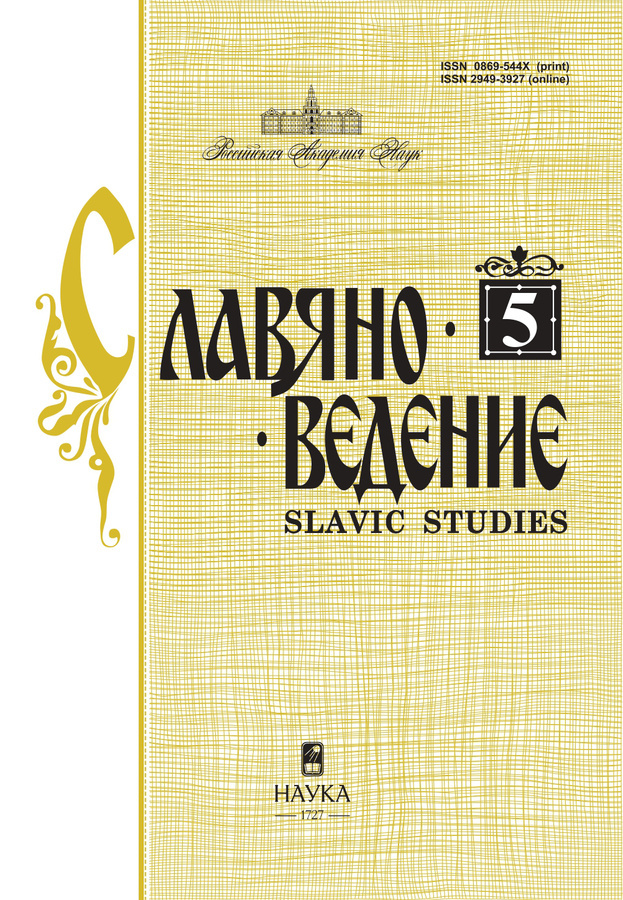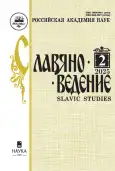The Image of the Ottoman Authorities in the Vitae of the Balkan Martyrs of the 16th Century
- Authors: Evstafyev N.V.1
-
Affiliations:
- Institute of Slavic Studies of Russian Academy of Sciences
- Issue: No 2 (2025)
- Pages: 34-49
- Section: Articles
- URL: https://gynecology.orscience.ru/0869-544X/article/view/680820
- DOI: https://doi.org/10.31857/S0869544X25020039
- EDN: https://elibrary.ru/IZKVVZ
- ID: 680820
Cite item
Abstract
The article examines how the images of the Ottoman authorities are presented in the Slavic hagiography of the 16th century (the vitae of the Balkan martyrs): first of all, the sultans, but also individual mayors («eparchs») and viziers. Despite some of the negative features the Ottoman Sultan acts most often as a neutral figure or even as a kind of arbitrator, to whom both a Muslim judge and some Christians turn for advice. It is the «tsar» who can decide what sentence to impose on a Christian martyr. This peculiarity of the image of the Ottoman ruler can be explained by the fact that for the compilers of the vitae he represents the only legitimate «tsar» to whom, despite his belonging to the «Hagarites» and their faith, they must obey as subjects. The contrast is presented in the image of some local rulers and senior officials: they often act as persecutors of Christianity. Moreover, in order to achieve their goal and destroy the future saint, these «eparchs» or «voivodes» resort to deception and flattery, forcing the «tsar» or judge himself to believe in their lies and pass a death sentence on a Christian. The image of a Muslim city or prison guardian given in the hagiography is also quite ambiguous. The guardian can act as a fairly positive character who is imbued with respect for the martyr and tries to alleviate his suffering, as well as organizes meetings of the future saint with other Christians. At the same time, Ottoman guards are characterized by human weaknesses: they can doze off on duty and take bribes.
Full Text
About the authors
Nikita V. Evstafyev
Institute of Slavic Studies of Russian Academy of Sciences
Author for correspondence.
Email: nikichan1@yandex.ru
ORCID iD: 0000-0002-6965-4112
Postgraduate Student, Junior Researcher
Russian Federation, MoscowReferences
- Babinger F. Mehmed the Conqueror and his time, transl. R. Manheim, ed. W.C. Hickman. Princeton, Princeton University Press, 1992, 550 p.
- Biliarsky I., Tsibranska-Kostova M. Historical Memory and Orthodox Faith: Byzance Après Byzance in Sofia Under Ottoman Rule. Vestnik VolGU. Seriia 4, Istoriia. Regionovedenije. Mezhdunarodnyje otnosheniia, 2021, t. 26, no. 6, pp. 339–351.
- Faroqhi S. Coping with the State: Political Conflict and Crime in the Ottoman Empire, 1550–1720. Istanbul, Isis Press, 2010, 205 p.
- Georgieva Ts. Enicharite v bŭlgarskite zemi. Sofiia, Nauka i izkustvo Publ., 1988, 239 p. (In Bulg.)
- Gradeva R. O nekotorykh problemakh formirovaniia osmanskoi sistemy upravleniia (XIV – nachalo XVI v.). Osmanskaia imperiia. Gosudarstvennaia vlast’ i sotsial’no-politicheskaia struktura. Moscow, Nauka Publ., 1990, pp. 40–65. (In Russ.)
- Gradeva R. The Church in the Life of Sofia Citizens, 15th to 18th century (preliminary notes). G. Valtchinova (ed.). Religion and Boundaries. Studies from the Balkans, Eastern Europe and Turkey. Istanbul, Isis Press, 2010, pp. 47–79.
- Gradeva R. Sofiĭskata katedralna tsŭrkva, XV – nachaloto na XІX vek. Iura Konstantinova i dr. (red.). Balkanite. Modernizatsiia, identichnosti, idei. Sbornik v chest na prof. Nadia Danova, Sofiia, IBTsT–Faber Publ., 2011, pp. 567–587. (In Bulg.)
- Gradeva R. Late Antique church buildings in Ottoman Sofia, fifteenth to beginning of nineteenth centuries. Christian Art under Muslim Rule. ed. by M. Hartmuth with the assistance of A. Dilsiz and A. Wharton. Leiden, Nederlands Instituut voor het Nabije oosten, 2016a, pp. 167–193.
- Gradeva R. Sofia’s Rotunda and Its Neighbourhood in Ottoman Times. Osmanische Welten: Quellen und Fallstudien. Festschrift fur Michael Ursinus. Hg von J. Zimmermann, Chr. Herzog und R. Motika. University of Bamberg Press, 2016b, pp. 177–208.
- Gradeva R. Za sŭdbata na sofiĭskata tsŭrkva «Sv. Georgi»-Rotonda pod osmanska vlast. St. Pŭrveva i O. Todorova (sŭst. i red.). Iz zhivota na evropeῐskite provintsii na Osmanskata imperiia prez XV–XIX vek. Sbornik izsledvaniia v pamet na prof. d.i.n. Elena Grozdanova. Sofiia, IK Gutenberg Publ., 2016, pp. 592–604. (In Bulg.)
- Inalcik H. The Ottoman Empire. The Classical Age 1300–1600. London; New York, Weidenfeld and Nicholson Publ., 1973, 385 p.
- Jevstaf’jev N.V. Vzgliad khristianskikh avtorov na praktiku devshirme v Osmanskoi imperii XVI veka, Slavianovedenije, 2024, no. 4, pp. 16–25. (In Russ.)
- Kaegi W.E., Kazhdan A. Phokas. ODB, ed. by A.P. Kazhdan. New York; Oxford, Oxford University Press,1991, vol. 3. p. 1666.
- Kaliganov I.I. Georgii Novyi u vostochnykh slavian. Moscow, Indrik Publ., 2000, 799 p. (In Russ.)
- Loseva O. Slavianskoje i grecheskoje zhitiia novomuchenika Ioanna Serrskogo. Tsrkvene studiјje, no. 9, Nish, 2012, pp. 447–453. (In Russ.)
- Makarova I.F. Bolgarskii narod v XV–XVIII vv. Moscow, KomKniga Publ., 2005, 192 p. (In Russ.)
- Makarova I.F. O vliianii konfessional’nogo soznaniia na etnicheskuiu istoriiu bolgar (XV – nachalo XIX v.). Slavianovedenije, 2008, no. 2, pp. 41–54. (In Russ.)
- Necipoğlu G. The Age of Sinan: Architectural Culture in The Ottoman Empire. London, Reaktion Books, 2005, 480 p.
- Pavlović L. Kultovi lica kod Srba i Makedonaca, Smederevo, Nar. Muzej Publ., 1965, 357 p. (In Serbian)
- Polyviannyi D.I. Kul’turnaia identichnost’, istoricheskoje soznanije i knizhnoje nasledije srednevekovoi Bolgarii, Moscow; St. Petersburg, Tsentr gumanitarnykh initsiativ Publ., 2018a, 512 p. (In Russ.)
- Polyviannyi D.I. Pochitanije moshchei sviatykh i sakral’naia geografiia srednevekovoi Bolgarii. Jevropa sviatykh. Sotsial’nyje, politicheskije i kul’turnyje storony sviatosti v Srednije veka, Moscow, Aleteiia Publ., 2018b, pp. 285–298. (In Russ.)
- Stainova M. Islam i islamskaia religioznaia propaganda v Bolgarii. Osmanskaia imperiia. Sistema gosudarstvennogo upravleniia, sotsial’nyje i etnoreligioznyje problemy. Moscow, Nauka Publ., 1986, pp. 83–102. (In Russ.)
- Tsibranska-Kostova M. Sviatoi i obshchestvo: konflikty i tsennosti («Zhitije sviatogo Nikolaia Novogo Sofiiskogo» Matveia Grammatika, XVI v.). Vzgliad na slavianskuiu aksikologiiu. Moscow, Institut slavianovedeniia RAN Publ., 2019, pp. 9–35. (In Russ.)
- Tsibranska-Kostova M. Nikolai Sofiiskii. PE. Moscow, Tserkovno-nauchnyi tsentr «Pravoslavnaia entsiklopediia» Publ., 2022, t. 50, pp. 605–606. (In Russ.)
- Turilov A.A. Zhitije prepodobnomuchenika Antoniia Suprasl’skogo i slavianskije zhitiia balkanskikh muchenikov XVI v.: K postanovke problemy. Hagiographia Slavica. München – Berlin – Wien, Verlag Otto Sagner, 2013 (= Wiener Slawistischer Almanach. Sonderband. Bd. 82), pp. 265–275. (In Russ.)
- Turilov A.A., Temelski Khr. Georgii Novyi Kratovskii. PE. Moscow, Tserkovno-nauchnyi tsentr «Pravoslavnaia entsiklopediia» Publ., 2009, t. 11, 70 pp. (In Russ.)
- Tzedopoulos Y. Orthodox Martyrdom and Confessionalization in the Ottoman Empire, Late Fifteenth–Mid-Seventeenth Centuries. Krstić T., Terzioǧlu D. (eds.) Entangled Confessionalizations? Dialogic Perspectives on the Politics of Piety and Community Building in the Ottoman Empire, 15th–18th centuries. Gorgias Press, 2022, pp. 335–382.
- Παναγιώτου Ἀ.Δ. Μανουὴλ Κορινθίου Ἀκολουθία Ἰωάννου Νεομάρτυρος τοῦ ἐν Σέρραις. Ἐπετηρὶς Ἑταιρείας Βυζαντινῶν Σπουδῶν, t. 47, Ἀθήνα, 1987/1989, σς. 423–445.
Supplementary files








